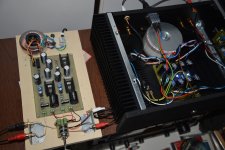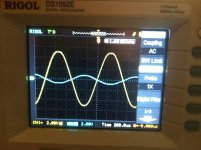The 2VRMS 'standard' is actually not a standard at all. Line level is .775Vrms for consumer audio (-10dBu). That works out to 3.1V P-P, the F5 needs about 7V P-P to clip the output.
What complicates it is that some recordings are made at significantly lower levels or have much larger dynamic range (such as quiet classical recordings) so the average level is too quiet most of the time.
The issue is that the F5 can deliver a clean peak of about 20V before clipping, so if your speakers are not sensitive enough you need new speakers (or a new amp) if most of your stuff is too quiet. This is stated pretty clearly in the F5 manual - no amount of gain in the preamp will help matters here. The amp will clip at 18-20V, so you need something that delivers your desired listening level at that input voltage.
What complicates it is that some recordings are made at significantly lower levels or have much larger dynamic range (such as quiet classical recordings) so the average level is too quiet most of the time.
The issue is that the F5 can deliver a clean peak of about 20V before clipping, so if your speakers are not sensitive enough you need new speakers (or a new amp) if most of your stuff is too quiet. This is stated pretty clearly in the F5 manual - no amount of gain in the preamp will help matters here. The amp will clip at 18-20V, so you need something that delivers your desired listening level at that input voltage.
2V is not a standard except that very few line level products are not rated for that or more.
Hi all,
If i remember right, i thing I read that it is needed to have matched pair of MOSFET for the F5. But for almost the same price I could get the Q3-Q4 as match quad!
What would be the best Idss range to use?
Thanks in advance
If i remember right, i thing I read that it is needed to have matched pair of MOSFET for the F5. But for almost the same price I could get the Q3-Q4 as match quad!
What would be the best Idss range to use?
Thanks in advance
High voltage
Has anyone run an F5 at higher than specified voltage? To make a long story short I am using a power supply that is putting out closer to +/- 28v, amp was working but one channel burnt up....appears to be around the Jfets.
Amp was been driven by a cheap off shore pre-amp that I am not sure if was cause or if amp was at fault. The amplifier was driving a ribbon speaker with 2 ohms impedance.
I have almost completed building new boards to replace but don't want to have this problem again. On that note regarding Jfet idss matching, I was able to match one pair at 3.8ma, and one at 5.0ma. Is having different values for left/right channel a problem?
Thanks
Has anyone run an F5 at higher than specified voltage? To make a long story short I am using a power supply that is putting out closer to +/- 28v, amp was working but one channel burnt up....appears to be around the Jfets.
Amp was been driven by a cheap off shore pre-amp that I am not sure if was cause or if amp was at fault. The amplifier was driving a ribbon speaker with 2 ohms impedance.
I have almost completed building new boards to replace but don't want to have this problem again. On that note regarding Jfet idss matching, I was able to match one pair at 3.8ma, and one at 5.0ma. Is having different values for left/right channel a problem?
Thanks
Just check the F5 Turbo article. http://www.firstwatt.com/pdf/art_f5_turbo.pdf
It will give plenty of directions how to run your F5 off a higher power supply voltage. According to Nelson the Toshiba JFETs should be able to handle +/- 28VDC just fine. Did you have trusted parts for the JFETs?
It will give plenty of directions how to run your F5 off a higher power supply voltage. According to Nelson the Toshiba JFETs should be able to handle +/- 28VDC just fine. Did you have trusted parts for the JFETs?
Just check the F5 Turbo article. http://www.firstwatt.com/pdf/art_f5_turbo.pdf
It will give plenty of directions how to run your F5 off a higher power supply voltage. According to Nelson the Toshiba JFETs should be able to handle +/- 28VDC just fine. Did you have trusted parts for the JFETs?
Thanks for the link, that is a huge help! As far as the JFets, they are from the DIY audio store...Linear Systems which I believe are trustworthy. I was definitely running too much bias so am going to run it lower now for safe measures.
I'm using the LSK170/LSJ74 parts running 32.5V rails and they're holding up just fine. They've been at it 8 or 9 months now. I do have a bit of copper heatsink between them.
Hi everyone, I'm notifying community that my project is complete. So, Pearl Two, B1 and F5 are up and running. First of all I would like to thank my audiphile god for the possibility to build this schematic! This had taken me four years and brought a lot of experiences. On this audiophile Qualitätsneveu I would never have come if I would buy equal quality. Thanks alot! The rest of the chain are Ortofon MC 30 super II and JBL Ti6K.
I'm overjoyed!
I'm overjoyed!
Hi everyone, I'm notifying community that my project is complete. So, Pearl Two, B1 and F5 are up and running. First of all I would like to thank my audiphile god for the possibility to build this schematic! This had taken me four years and brought a lot of experiences. On this audiophile Qualitätsneveu I would never have come if I would buy equal quality. Thanks alot! The rest of the chain are Ortofon MC 30 super II and JBL Ti6K.
I'm overjoyed!
Attachments
-
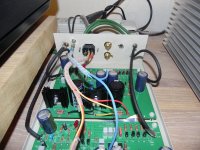 DSCN2698_01.JPG581.5 KB · Views: 279
DSCN2698_01.JPG581.5 KB · Views: 279 -
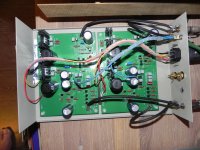 DSCN2697_01.JPG586.5 KB · Views: 293
DSCN2697_01.JPG586.5 KB · Views: 293 -
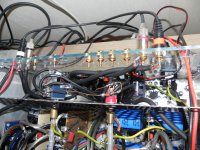 DSCN2696_01.JPG631.1 KB · Views: 532
DSCN2696_01.JPG631.1 KB · Views: 532 -
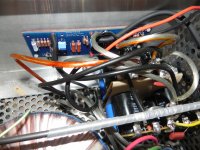 DSCN2695_01.JPG545.4 KB · Views: 549
DSCN2695_01.JPG545.4 KB · Views: 549 -
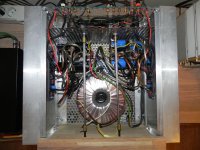 DSCN2694_01.JPG580.7 KB · Views: 551
DSCN2694_01.JPG580.7 KB · Views: 551 -
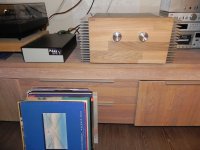 DSCN2693_01.JPG311.2 KB · Views: 620
DSCN2693_01.JPG311.2 KB · Views: 620 -
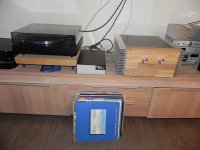 DSCN2692_01.JPG302.4 KB · Views: 629
DSCN2692_01.JPG302.4 KB · Views: 629 -
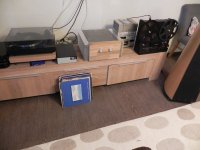 DSCN2691_01.JPG282.9 KB · Views: 271
DSCN2691_01.JPG282.9 KB · Views: 271
Nice job!
If the power supply input of the PearlII is an IEC mains connector, I would recommend changing it to something less risky, like a Neutrik XLR or the like. In the best case it takes only one uninformed member of your surroundings to put 240VAC on your circuit boards.
Worst case is that you plug in a mains cable yourself.
My dad told me that when he was young he'd figure mains plugs were a good and solid connector for his DIY speakers, until my granddad saw a loose plug lying around and decided to put it where it belongs. Carnage guaranteed. 🙂
If the power supply input of the PearlII is an IEC mains connector, I would recommend changing it to something less risky, like a Neutrik XLR or the like. In the best case it takes only one uninformed member of your surroundings to put 240VAC on your circuit boards.
Worst case is that you plug in a mains cable yourself.
My dad told me that when he was young he'd figure mains plugs were a good and solid connector for his DIY speakers, until my granddad saw a loose plug lying around and decided to put it where it belongs. Carnage guaranteed. 🙂
Hello, this is IEC-60320 C15/C15a and C16/C16a connection, which is theonly one in the household and therewith no one to mess with. It was chep, that's why. 🙂
Hello, this is IEC-60320 C15/C15a and C16/C16a connection, which is theonly one in the household and therewith no one to mess with. It was chep, that's why. 🙂
Ah. All good then 😀
As long as no one can blow up your precious fruits of labour. 🙂
Hello community,
I have this chain: Pearl Two, B1 and F5 finished, as I have already written I am overjoyed and have to continue to spend a lot of time. Despite all my question: whether someone has already built these devices symmetrical?
Do not want to spend too much time looking for plans.
Thank you.
I have this chain: Pearl Two, B1 and F5 finished, as I have already written I am overjoyed and have to continue to spend a lot of time. Despite all my question: whether someone has already built these devices symmetrical?
Do not want to spend too much time looking for plans.
Thank you.
Hello community,
I have this chain: Pearl Two, B1 and F5 finished, as I have already written I am overjoyed and have to continue to spend a lot of time. Despite all my question: whether someone has already built these devices symmetrical?
Do not want to spend too much time looking for plans.
Thank you.
Pearl 2, no. B1 has DCB1 and B1 rev2 variants. F5 is already symmetrical.
- Home
- Amplifiers
- Pass Labs
- F5 power amplifier
